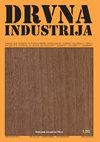Effect of Epoxy Resin Reinforcement on Screw Withdrawal Strength of Fiberboard and Particleboard Used in Furniture Industry
IF 0.8
4区 农林科学
Q4 MATERIALS SCIENCE, PAPER & WOOD
引用次数: 0
Abstract
The study aimed to increase the screw withdrawal strength of medium density fiberboard and particleboard used in furniture strength by using epoxy resin in the screw pilot hole. Therefore, the effects of pilot hole diameters, screw diameter, and amount of epoxy resin on screw withdrawal strength of medium density fiberboard and particleboard from face and edge were investigated. According to TS EN 13446, 50 mm × 50 mm specimens were cut from commercial medium density fiberboard and particleboard boards. A static load was applied parallel to the screw direction. The screw withdrawal strength of medium density fiberboard was higher than the screw withdrawal strength of particleboard because of its density. Besides, the screw withdrawal strength of medium density fiberboard and particleboard samples with a 3.5 mm screw diameter was higher compared to those with a 4.5 mm screw diameter. A decrease in pilot hole diameter and an increase in the amount of epoxy resin provided higher screw withdrawal strength of materials. Using 20 % epoxy resin of the volume of the pilot hole resulted in two times better screw withdrawal strength values. The study showed that a higher amount of epoxy resin, smaller pilot hole diameter, and smaller screw diameter contribute to better screw withdrawal strength of both medium density fiberboard and particleboard from the face and edge.环氧树脂加固对家具业所用纤维板和刨花板螺钉抽出强度的影响
该研究旨在通过在螺钉导向孔中使用环氧树脂来提高家具强度中使用的中密度纤维板和刨花板的螺钉抽出强度。因此,研究了导向孔直径、螺钉直径和环氧树脂用量对中密度纤维板和刨花板从表面和边缘的螺钉抽出强度的影响。根据 TS EN 13446,从商用中密度纤维板和刨花板上切割出 50 mm × 50 mm 的试样。平行于螺钉方向施加静载荷。由于密度的原因,中密度纤维板的螺钉抽出强度高于刨花板的螺钉抽出强度。此外,螺钉直径为 3.5 毫米的中密度纤维板和刨花板样品的螺钉抽出强度也高于螺钉直径为 4.5 毫米的样品。减小导向孔直径和增加环氧树脂用量可提高材料的螺钉抽出强度。使用占导向孔体积 20% 的环氧树脂可使螺钉抽出强度值提高两倍。研究表明,环氧树脂用量越大、导向孔直径越小、螺钉直径越小,中密度纤维板和刨花板从表面和边缘的螺钉抽出强度就越高。
本文章由计算机程序翻译,如有差异,请以英文原文为准。
求助全文
约1分钟内获得全文
求助全文
来源期刊

Drvna Industrija
MATERIALS SCIENCE, PAPER & WOOD-
CiteScore
1.80
自引率
9.10%
发文量
32
审稿时长
>12 weeks
期刊介绍:
"Drvna industrija" ("Wood Industry") journal publishes original scientific and review papers, short notes, professional papers, conference papers, reports, professional information, bibliographical and survey articles and general notes relating to the forestry exploitation, biology, chemistry, physics and technology of wood, pulp and paper and wood components, including production, management and marketing aspects in the woodworking industry.
 求助内容:
求助内容: 应助结果提醒方式:
应助结果提醒方式:


